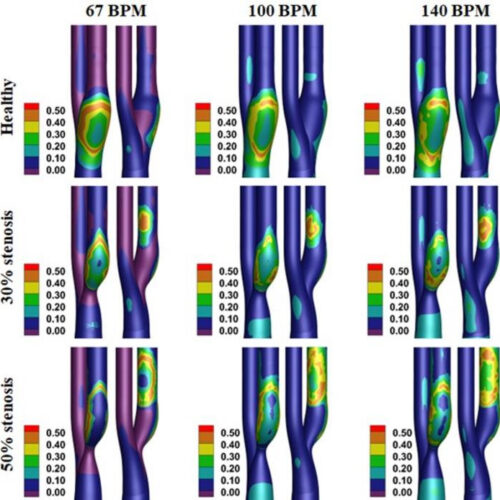AMERICAN INSTITUTE OF PHYSICS IMAGE: CONTOURS OF OSCILLATORY SHEAR INDEX (OSI) ON HEALTHY, 30% STENOSIS, AND 50% STENOSIS CAROTID ARTERIES FOR THE NORMAL (67 BEATS PER MINUTE), MODERATE (100 BPM), AND HIGH EXERCISE (140 BPM) HEART RATES. CREDIT: KHAN ET AL. WASHINGTON, June 20, 2023 – Many overlook the warnings preceding workout classes that encourage...
Study links hormones, blood sugar, blood lipids, and BMI to the severity of major depressive disorder and suicide risk
by Association of Basic Medical Sciences of FBIH Hypothalamus-pituitary-adrenal axis (HPA axis) dysfunction is one of the important biochemical changes in depression. The development of depression will lead to changes in the function of HPA axis. Credit: Bosnian Journal of Basic Medical Sciences (2022). DOI: 10.17305/bjbms.2021.6754 A study, published in the Bosnian Journal of Basic Medical Sciences, provides insights into...
Extraocular muscles may provide key to defensive mechanisms against amyotrophic lateral sclerosis
by Umea University Credit: Pixabay/CC0 Public Domain A unique type of muscle fiber found in the extraocular muscles has been shown to be resistant against the disease amyotrophic lateral sclerosis (ALS), and has been shown to even increase in proportion to compensate when other types of muscle fibers decrease in proportion. This finding, by researchers at Umeå University...
Why Most People Regain Lost Weight? Obesity Severely Impairs the Brain’s Response to Nutrients
By AMSTERDAM UNIVERSITY MEDICAL CENTERS JUNE 18, 2023 New research indicates that brain responses to nutrients are diminished in people with obesity and don’t improve even after weight loss. The study revealed that individuals with obesity released less dopamine in a brain region crucial for food intake motivation, compared to those with healthy body weight. Additionally, obese participants showed...
A 16-year-old pocketed $50,000 for her award-winning discovery in the brains of people who died by suicide
Adam BarnesSun, June 18, 2023 at 6:53 AM MST Natasha Kulviwat, 16, conducted her research project at a Columbia University lab. Natasha Kulviwat Natasha Kulviwat recently won $50K at the Regeneron International Science and Engineering Fair. She is 16 years old and a high school student with a passion for studying suicide prevention. She researches the brains...
Huntington’s spreads like ‘fire in the brain.’ Scientists say they’ve found the spark
June 19, 20235:01 AM ET In Huntington’s disease, proteins form toxic clumps that kill brain cells. Stowers Institute for Medical Research Diseases like Alzheimer’s, Parkinson’s, and Huntington’s are caused by toxic clumps of proteins that spread through the brain like a forest fire. Now scientists say they’ve figured out how the fire starts in at...
World’s first space factory, now in orbit, is also a hypersonic test bed
By Loz Blain June 13, 2023 As the “space factory” falls from orbit, it’ll hit the atmosphere at upwards of Mach 25, making it an attractive proposition as a hypersonic test bedVarda California startup Varda has celebrated the deployment of its first satellite, a test run of a fascinating space-based pharmaceuticals factory that moonlights as...
Playing With the Music of the Brain
Common neurological disorders like depression and chronic pain can be challenging to treat with conventional methods. An automated version of a long-used brain stimulation technique holds real promise as a reliable and effective drug-free alternative. When discussing the brain, Risto Ilmoniemi has a striking habit: he points at his own. So, as he describes the relationship...
AI Helps Show How The Brain’s Fluids Flow
Posted Yesterday New research targets brain diseases including Alzheimer’s. A new artificial intelligence-based technique for measuring fluid flow around the brain’s blood vessels could have big implications for developing treatments for diseases such as Alzheimer’s. The perivascular spaces that surround cerebral blood vessels transport water-like fluids around the brain and help sweep away waste. Alterations in the...
Oral probiotic shows promise for treating dry eye disease in mouse study
by American Society for Microbiology In a study by a research group at Baylor College of Medicine, oral administration of a commercially available probiotic bacterial strain was found to improve dry eye disease in an animal model. The findings were presented at ASM Microbe 2023, the annual meeting of the American Society for Microbiology. Dry eye, a...








